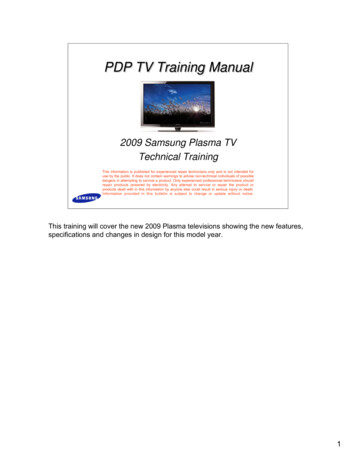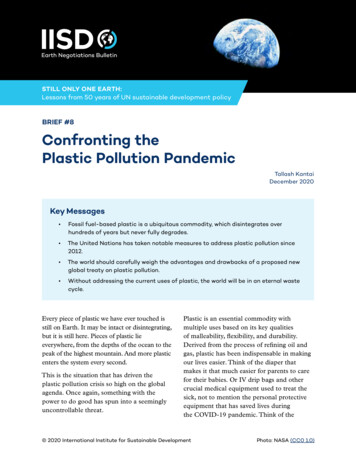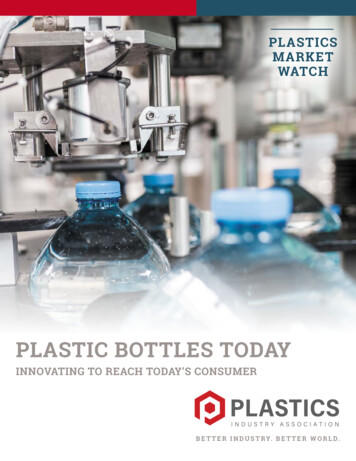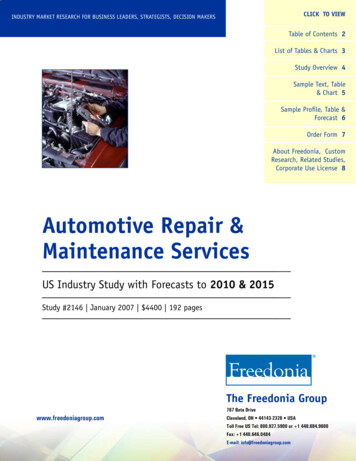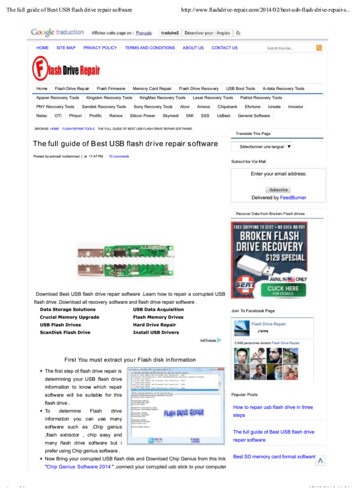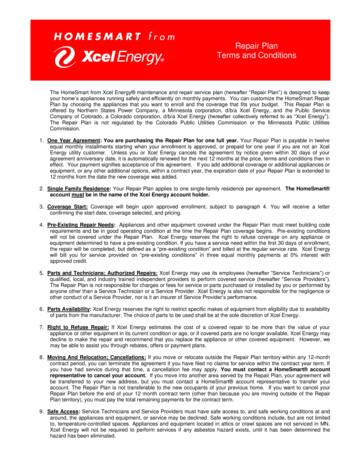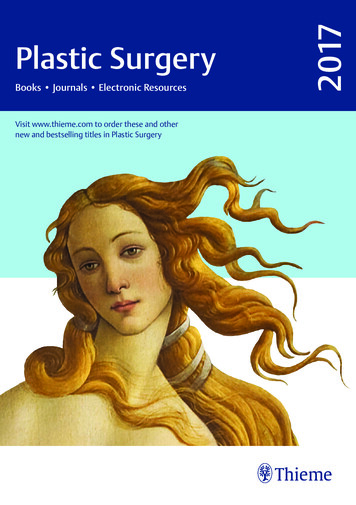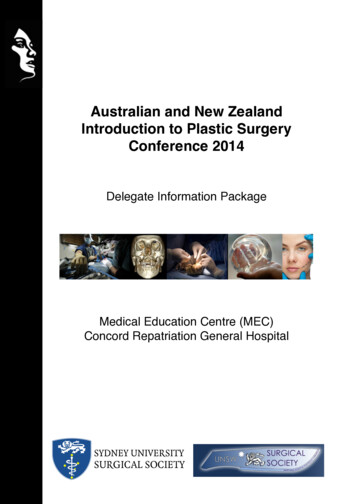
Transcription
COMPLIMENTS OFTHEBOOKO F P L A S T I C R E PA I RA comprehensive guide to identifying, repairingand refinishing virtually any plastic.11t h Ed i t i o nCopyright 2019 Polyvance All Rights Reserved
TABLE OF CONTENTSwww.polyvance.comPage 2Every step of the way, Polyvance has what you need!Born as Urethane Supply Company in 1981, Polyvance has been at the forefront of automotive plastic repair technology eversince. We introduced the industry’s first and most popular airless plastic welder back in 1983. Since then, our list of plasticrepair innovations have continued to grow. In 1999, we developed Uni-Weld FiberFlex ; a universal rod that eliminates the needto identify plastic while being very strong with its fiber reinforcement. In 2000, we introduced the PlastiFix Rigid Plastic RepairKit, a revolutionary method for repairing rigid plastics like ABS and polycarbonate. In 2002 we introduced the revolutionary lineof Bumper and Cladding Coat paint and in 2006 we introduced the world to welding plastic with nitrogen gas, a quantum leapin plastic repair. Through our continual quest to innovate, we have created products to make plastic repair easier, stronger andmore profitable for the user, year after year!Plastic ID Reference Chart. 3Welding Rod Part Number Chart . 9Unidentified Plastic ID Flow Chart. 4Nitrogen Welding - Crack Repair. 10-11Preparing the Repair Area. 4Nitrogen Welding - Bumper Slot Repair. 12Thermoplastic Fusion Weld Repair. 5Two-Part Adhesive Repair. 13Uni-Weld FiberFlex Repair. 6PlastiFix Rigid Plastic Repair. 14Thermoset Urethane Repair. 7Refinishing Repaired Plastics. 15Repairing Broken Tabs and Torn Bolt Holes. 8Refinishing Raw Plastic Bumpers. 16Padded Dash Repair. 8Additional Repair Resources. 16Nitrogen Welding - Overview. 9PLASTIC REPAIR QUICK REFERENCE CHARTAW-1, N2-1Pages 5 - 8IdentifyPlastic2CleanRepair Step13Page 3Pages 9-12ABS, HDPE*, LDPE*,PA-6 (nylon), PBT, PC,PP, PVC, TEO, TPE, TPORepair MethodAW-2AD-1AW-3Page 6Page 7Page 13PP, TPO, TEO,TPE, PE, orotherThermosetPolyurethaneSMC, UP, FRP,FiberglassPF-1Page 14ABS, Acrylic, SMC,Fiberglass, PCblend, Metton Clean part with soap & water and plastic cleanerPage 4ThermoplasticAirless WeldingUni-WeldFiberFlex ThermosetUrethane WeldTwo-PartAdhesiveRepairPage 5 - 14Nitrogen Welding456FillGrind, then apply filler that matches the hardness of the substratePrimePrimePaintApply Top Coat *Page 15Page 15Page 15 PlastiFix RigidPlastic RepairKit* Polyethylenes cannot be painted without special preparation. Go to www.polyvance.com for complete instructions.
IDENTIFY PLASTIC & DETERMINE REPAIR METHODPage 3800.633.3047Identify the type of plastic by looking for the plastic ID symbol on the backside of the part. Match the symbol on the part withthe table below. The recommended repair method is listed first. See the next page for tips when the identification symbol orabbreviation is missing.ThermosetRecyclingSymbolSymbol& TypeDescription/How to IdentifySuggestedRepair MethodRepairTipsPUR, RIM, RRIMUsually flexible, may beThermoset Polyure- yellow or gray, bubbles &thanesmokes when attemptingto melt.SMC, UP, FRPRigid, polyester matrixFiberglassreinforced with glassfibers, sands finely.Flexible bumper covers (esp. ondomestics,) filler panels, rockerpanel covers, snowmobile cowls.Method AW-3 w/ urethane(R01) rod or method AW-2with Uni-Weld FiberFlexRigid body panels, fenders,hoods, deck lids, header panels,spoilers.Method AD-1 Two-part adhe- Use backing plate oversive repair with fiberglassholes, layer in fiberglassreinforcementcloth for extra strength.DCPD, Metton Large truck and tractor panelsand hoods.Method AD-1 w/ 2510PlastiFix two-part methacrylate adhesiveUse backing plate overholes, layer in fiberglasscloth for extra strength.Gas tanks, kayaks, canoes, trashcans, use is decliningMethod AW-3 withpolyethylene (R04) rod, useas hot melt adhesiveApplying filler or paintingis difficult or impossible.Browns when heated.Rigid material, no fibers,gray in color.XPE, XLPE, PE-Xb, Semi-flexible, waxy orPEX, Crosslinkedgreasy feel, softens whenPolyethyleneheated but does not melt.ThermoplasticTypicalApplicationsDon’t melt base material!Melt rod into v-groove likea hot melt glue.ABSAcrylonitrile Butadiene StyreneRigid, often white but may Instrument panels, grilles, trimbe molded in any color,moldings, consoles, armrest supsands finely.ports, street bike fairings, canoes,aircraft wing tips and interiors.Method AW-1 or N2-1 w/ ABS PlastiFix is an optimal(R03 series) rod or methods repair method. WeldPF-1 or AD-1repairs may be backed withepoxy for extra strength.PBT Polybutyleneterephthalate(polyester)Semi-rigid or rigid, sandsfinely.Automotive panels, electrical connectors, under-hood partsMethod AW-1 or N2-1 withslivers cut from scrapPA, PA-6Polyamide (Nylon)Semi-rigid or rigid, sandsfinely.Radiator tanks, head lamp bezels, Method AW-1 or N2-1 w/exterior trim parts, mirrors, plastic nylon (R06 series) rodengine parts.PC ABSPulse (Polycarbonate & ABS)Rigid, sands finely, usually dark in color.Door skins (Saturn), instrumentpanels, street bike fairings.Method AW-1 or N2-1 w/Preheat plastic with heatPC ABS (R20 series) rod or gun before welding.methods PF-1 or AD-1PC PBTVery rigid, sands finely,Xenoy (Polycarbon- usually dark in color.ate blend)Bumper covers (84-95 FordTaurus, Aerostar, some M-B andHyundai).Method AW-1 or N2-1 w/ PC Preheat plastic with heat(R07 series) rod or methods gun before welding.PF-1 or AD-1HDPEPolyethyleneSemi-flexible, melts &smears when grinding,usually semi-translucent,waxy or greasy feel.Semi-flexible, melts &smears when grinding,usually semi-translucent,waxy or greasy feel.Semi-flexible, melts &smears when grinding,waxy or greasy feel, usually a bit stiffer than PEs.Semi-rigid, sands finely,usually off-white or blackin color.Semi-rigid, sands finely,usually off-white in color.Overflow tanks, inner fenderMethod AW-1 or N2-1 withpanels, ATV fenders, RV waterhigh density polyethylenestorage tanks, gas tanks, kayaks (R12 series) rodcanoes, playground equipmentOverflow tanks, inner fenderMethod AW-1 or N2-1 withpanels, ATV fenders, RV waterpolyethylene (R04 series) rodstorage tanks, gas tanks, kayaks,canoes, trash cansMethod AW-1 or N2-1 w/Bumper covers (usually blendedw/ EPDM), inner fenders, radiator (R02 series) or method AW-2shrouds, gas tanks, battery cases, with (R10 series) Uni-WeldpalletsFiberFlexFenders, exterior trim, rear hatchMethod AW-1 or N2-1 w/panels.PPE PS (R08 series) rod orAD-1 or PF-1Fenders (Saturn & GM), exteriorMethod AW-1 or N2-1 withtrim.GTX (R15 series) rod ornylon (R06 series) rodPVCPolyvinyl chlorideRigid, sands finely. Usually white or gray but canbe made any color.Pipe, siding, window frames,decking, gutters, speed bumpsMethod AW-1 or N2-1 withPVC (R09 series) weldingrod or AD-1 or PF-1TPEThermoplasticElastomerSemi-flexible, usuallyblack or gray, melts &smears when grinding.Bumper covers, filler panels,underhood parts.Method AW-2 with (R10series) Uni-Weld FiberFlexUse 1060FP Filler Prepbefore applying two-partepoxy filler.TPO, TEO, PP/EPDM, TSOPThermoplasticOlefinTPU, TPURThermoplasticPolyurethanePETE, PETPolyethyleneTerephthalateSemi-flexible, usuallyblack or gray, melts &smears when grinding.Bumper covers, air dams, grilles,interior parts, instrument panels,snowmobile cowls.Use 1060FP Filler Prepbefore applying two-partepoxy filler.Flexible, sands finely.Bumper covers, soft filler panels,gravel deflectors, rocker panelcovers.Soda bottles, various yarn fibers,headliners, fuse boxes, doorpanelsMethod AW-1 or N2-1 w/ PP(R02 series) rod or TPO (R05series) rod or method AW-2w/(R10 series) FiberFlex rod.Method AW-3 w/ (R01 series)rod or method AW-2 with(R10 series) FiberFlex rodMethod AW-1 or N2-1 withPET (R13 series) rodPE/LDPEPolyethylenePPPolypropylenePPE, PPE PSPolyphenyleneEtherPPO PA, PPE PANoryl GTX(Nylon blend)Flexible, strong.Crystalline type plastic. Haslow coefficient of friction.Use heavy pressure andreinforce with 2045 mesh.Preheat plastic with heatgun before welding, mixcompletely with base mat’l.Applying filler or painting isimpossible.Applying filler or painting isimpossible.Use 1060FP Filler Prepbefore applying two-partepoxy filler.Preheat plastic with heatgun before welding.Preheat plastic with heatgun before welding.Can’t make as strong asoriginal part; manufacturedin crisscrossed layers andcan’t be duplicated.
IDENTIFY PLASTIC & DETERMINE REPAIR METHODwww.polyvance.comPage 4Identification Processfor BumpersIf you can’t find the Plastic ID Symbol.Note: weldermust be veryhot to perform this testeffectively.Identification Processfor Plastics in GeneralIs the part veryrigid with lots ofglass fibers in thebroken area?YesProbablySMC. Repair usingmethod AD-1 with2020 or 2510 rigidadhesiveFlexibleProbablyurethane. Repairusing method AW-3with urethane (R01series) rod. If waxyfeeling, may also becrosslinked polyethylene. Repair usingmethod AW-3 withPE (R04 series) rodIs the plasticextremely rigid?YesNoXenoy (PC/PBT).Repair using methodAW-1 or N2-1 withpolycarbonate (R07series) rod.Does it smoke a lot, bubble, orbrown when you try to melt it andgenerally not behaving as you wouldexpect plastic to melt?YesFlexible or rigid?RigidThermoset rigidplastic, like Metton .Repair using methodAD-1 with 2020 or2510 rigid adhesiveor method PF-1PlastiFix Rigid Plastic Repair System**To perform a test weld, clean and sand a smallarea on the backside of the part. Make a smallspot weld on the surface. After the weld cools, tryto pick it off with your fingernail or a screwdriver.The one that sticks best is the one to use.NoDo any of these rods stickwell?YesRepair withselected welding rodusing method AW-1 orN2-1.Is thebackside of thepart yellow?NoDoes it bubbleand smoke whenyou try to melt itthen remain tacky orgummy when cool?YesYesJudging from the feel andappearance of the plastic,test weld** with one thatmatches best.Very rigid - R07, R20Rigid - R03, R06, R13,R14, R15Semi-rigid - R02, R04, R05Flexible - R04Note: weldermust be veryhot to perform this testeffectively.NoNoIf rigid, repair withmethod PF-1 PlastiFix Rigid Plastic RepairSystem.If semi-rigid, probablyTPO, TEO, or PPRepair using method AW-2with Uni-Weld FiberFlex or method AW-1 or N2-1with (R02 series)polypropylene rod.Polyurethane.Repair usingmethod AW-3 withurethane (R01series) rod.NoProbably TPO, TEO,or PP. Repair usingmethod AW-2 with Uni-WeldFiberFlex or method AW-1or N2-1 with (R02 series)polypropylene rod.More than 95% of late modelbumper covers are made fromone of three materials. Theapproximate breakdown is:TPO, TEO, PP.95%PUR.3%Xenoy.1%Other.1%NOTE: SEE PAGE 9 FOR WELDING RODPART NUMBERING CHARTPREPARING PLASTIC FOR ALL REPAIRSClean SurfaceIn order to maximize strength any repair, thoroughly clean contaminants from the surface in the damaged area.Step 1. Clean both sides with soap and water. Dry with a clean cloth or compressed air.Step 2. Spray 1000 Super Prep or 1001-4 EcoPrep Plastic Cleaner onto the surface and wipe off while wet with aclean, lint-free cloth. Wipe in one direction to avoid spreading contaminants back over the clean area.Align Damage, Remove Dents and DeformationIf the plastic is distorted, heat with a heat gun and reshape the distorted area. When heating plastic, it is importantthat the plastic be heated all the way through. Hold the heat gun on the area until the opposite side of the plasticis uncomfortable to the touch. Once heated, force the plastic back into position with 6148 Bumper Rollers or otherappropriate tool, then cool the area with a damp cloth. Stretched areas can be shrunk with the bumper cold. Keepworking until smooth, then sand overall with 80 grit to help identify remaining low spots. Push out remaining low spotsand repeat the process.Thermoset polyurethanes (PUR, RIM) have a “memory” that will often cause them to go back to their original position ifheld under a heat lamp or in a heated spray booth.If the part is cut or torn to the edge, align the cosmetic surface with 6482 or 6485 Aluminum Body Tape and begin therepair process on the back. By aligning the outer surface, you minimize the amount of filler required to restore the properprofile to the part.
REPAIR METHOD AW-1: FUSION WELDINGPage 5800.633.3047Repairing Thermoplastics with Fusion Welding using Airless Plastic WelderExcluding urethane bumpers, all bumpers, and nearly all other plastics on automobiles andnearly everything else made of plastic, are made of thermoplastic materials. This meansthey can be melted with the application of heat. Thermoplastic parts are made by meltingpellets of plastic and injecting the melted material into a mold, where it cools and solidifies.This means that thermoplastic parts can be melted.The most common thermoplastic automobile bumper material is TPO. TPO is fastbecoming the most popular material for all sorts of interior and underhood plastics as well.TPOs can be welded using the fusion technique described on this page, but our FiberFlex rod often makes an easier and stronger repair on TPO (see Repair Method AW-2, Page6). The strongest way to repair any thermoplastic is with our nitrogen welding process (seeRepair Method N2-1, Pages 9 - 12).ThermoplasticThe least common bumper material, Xenoy, is best repaired using the followingthermoplastic fusion technique.V-Groove Damaged Area Line up the outer surface of the tear with 6482 or 6485 Aluminum BodyTape or with clamps. V-groove halfway through the part with either the 6121-T Teardrop CutterBit and a rotary tool or the sharp edge of the plastic welding tip. Remove the paint in the area surrounding the v-groove and radius into thev-groove with coarse sandpaper.Melt the Rod Together with the Base Material Set the temperature setting of your airless plastic welder to the settingthat’s appropriate for the welding rod you selected in the identificationprocess. In most cases, the welding rod should melt cleanly and not bediscolored (the only exception would be nylon, where the rod should turna light brown). Lay the welder tip on the surface of the plastic and slowly melt the rod intothe v-groove. Pull the welder toward you so you can see the welding rodfill the v-groove as you make your pass. Lay down no more than 2 inches of welding rod into the v-groove at atime. Remove the rod from the welder tip, and before the melted rod hastime to cool down, go back over it with the hot welder tip and thoroughlymelt the rod together with the base material. It helps to press into theplastic with the edge of the welder tip to mix the materials, then go backand smooth it out. Keep the heat on it until you have a good mix betweenthe rod and base.V-Groove and Weld Opposite Side After the weld on the backside cools, repeat the v-grooving and welding processon the opposite side.Grind Weld to a Smooth Contour If you need to refinish the plastic, grind weld to a smooth contour withcoarse sandpaper. Grind the weld slightly flush so that filler can cover thewelded area completely. Follow instructions for filler application. (Page 15)
REPAIR METHOD AW-2: FIBERFLEX www.polyvance.comPage 6Repairing with Uni-Weld FiberFlex Universal RodUni-Weld FiberFlex is a unique repair material in that it sticks to any plastic substrate. It is not a true welding rod, butrather a thermoplastic or hot-melt adhesive. When you do a repair with the FiberFlex , you will actually be using theheat of the welder to apply an adhesive. FiberFlex has a very strong bond and is reinforced with carbon and glassfibers for outstanding strength.FiberFlex is a popular way to repair TPOs (aka TEO, PP/EPDM, TSOP), the most common automotive bumper material. The reason is that there are no two TPOs that are exactly alike. As a result, our TPO (R05 series) welding rod willnot match any TPO exactly.FiberFlex can also be used to repair virtually any plastic. It will stick to urethanes and Xenoy also. When you are notsure what type of plastic you are repairing, try FiberFlex .V-Groove Damaged Area Line up the outer surface of the tear with 6482 or 6485 Aluminum BodyTape or with clamps. Grind away plastic into the shape of a broad V-groove halfway throughthe backside of the part using a die grinder with the 6122 Heavy DutyRound Burr, 6125 Heavy Duty Tapered Burr or the 6134-R Round CutterBit. You’ll want the v-groove to be about 1-1/2 inches wide when you getdone. It is very important to put some “tooth” in the plastic by grinding thev-groove with 50 grit or coarser sandpaper. Use a low speed grinder.Grinding at high speed will tend to melt many thermoplastics. Using 80 grit in a DA sander, feather back the paint in the area aroundthe v-groove and radius smoothly into the v-groove. This will give you abetter featheredge when you get ready to sand the FiberFlex .Melt on the FiberFlex With the airless welder set to the highest temperature setting, use the6031 Teardrop Welding Tip to melt the (R10-04) FiberFlex welding rodonto the surface. Best adhesion is achieved by pre-melting one side ofthe end of the rod, then flipping the rod over so that the melted portionsticks to the plastic. Cut the melted part of the ribbon off using the edgeof the welder tip and spread the FiberFlex into the v-groove. Do notattempt to melt the base material together with the FiberFlex . Repairingwith FiberFlex is similar to a brazing process.V-Groove and Weld Opposite Side After the FiberFlex on the backside cools (you may force cool withwater), repeat the v-grooving and welding process on the opposite side.Build the FiberFlex slightly higher than the surface. FiberFlex is also asandable filler.Finish Sand After allowing the FiberFlex to cool completely, sand with 80 grit paperin a DA sander at low speed. Progress to finer grits, ending with 320grit. Fill any low spots with more FiberFlex or with a skim coat of 2000 FlexFiller 2 or 2020 Hardset filler.
REPAIR METHOD AW-3: THERMOSET URETHANEPage 7800.633.3047Repairing Thermoset UrethanesAutomotive urethane, or PUR, is a “thermoset” material. Similar to what happens whenmixing body filler and cream hardener, thermoset plastic is formed when two liquid chemicalscome together in the mold to form a solid. The importance of this is that if polyurethane is“melted” the plastic decomposes and prevents adhesion of repair materials. DO NOT TRYTO MELT URETHANE BUMPERS WITH THE WELDER!A positive way to identify urethane bumpers is to press a HOT welding tip into the backsideof the bumper. If it’s a urethane, the plastic will liquefy, bubble and smoke. (Note: weldermust be extremely hot for this to happen). After the heated area cools off, it will remaingummy or tacky. This is an indication that the heat broke down the chemicals in the plastic.Thermoset urethanes can be easily repaired with the airless plastic welder, but the repair willbe more like brazing rather than a true fusion weld.ThermosetV-Groove Damaged Area Line up the outer surface of the tear with 6482 or 6485 Aluminum Body Tape orwith clamps. V-groove halfway through the back side of the part with the 6121-T TeardropCutter Bit or the 6125 Tapered Burr. You cannot use a hot tool to melt thev-groove into urethane because it will decompose. Sand the v-groove with coarse sandpaper (80 grit or coarser) to put “tooth” intothe plastic. Also, remove the paint in the area surrounding the v-groove andradius the edges of the v-groove for extra strength.Melt the Rod into the V-Groove Turn the temperature of your airless plastic welder to the “R01” rod setting.Using the (R01 series) urethane welding rod, the rod should come out of thebottom of the welder’s shoe completely melted and clear, not discolored or bubbling. Turn your welder up or down as needed, until you get this result. Holding the welder’s tip slightly off the surface of the plastic, melt the rod intothe v-groove. Don’t overheat the base material, simply melt the rod onto thesurface. Again, you are NOT trying to melt the rod and the bumper together; thebumper material is NOT meltable! Lay down no more than 2 inches of welding rod into the v-groove at a time.Remove the rod from the welder tip, and before the melted rod has time to cooldown, go back over it with the hot welder tip and smooth out the well. You cantouch the bumper with the welding tip, but keep the tip moving so you don’toverheat the base material.V-Groove and Weld Opposite Side After the weld on the back side cools, repeat the V-groove and welding processon the cosmetic side. V-groove deep enough to penetrate the welding rod onthe back side.Grind Weld to a Smooth Contour Using coarse sandpaper, grind the weld to a smooth contour. The urethanewelding rod will not feather very well, so it will need to be covered with 2000FlexFiller 2TM epoxy filler to refinish completely. Grind the weld slightly belowflush so that filler can cover the welded area completely. Follow instructions forfiller application. (Page 13)Repairing Torn Bolt Holes on Urethanes Taper the plastic all around the hole down to a point on both sides using aRolocTM disc. Use 6482 or 6485 Aluminum Body Tape to create a bridge across the tornmounting hole. Melt (R01 series) urethane welding rod into the area. Drill outhole when finished.
REPAIRING TABS & HOLES W/ AIRLESS WELDERwww.polyvance.comPage 8Repairing Flexible Tabs on TEO PlasticsMany TEO bumpers have mounting tabs that have to flex during installation. These can berepaired very durably with the mesh and FiberFlex . First, rough grind the area with a coarsesandpaper disc.Cut 2045W stainless steel wire mesh to size to fit in the corner areas on both sides of the tab.Using the hot welder tip, bury the mesh directly into the plastic. After you’ve melted the meshinto the plastic, scuff the melted plastic with coarse sandpaper to remove the gloss.Melt on a thin layer of FiberFlex over the mesh just to cover. In this repair, the mesh providesthe strength and flexibility while the FiberFlex just gives a cosmetic covering.Repairing Torn TabsRough grind the area surrounding the crack with a coarse RolocTM disc.Cut 2045W stainless steel wire mesh to size to fit in the corner areas. Using the hot welder tip,bury the mesh directly into the plastic. (This won’t work on urethane parts since they don’t melt.See Page 7). After you’ve melted the mesh into the plastic, scuff the melted plastic with coarsesandpaper to remove the gloss.Melt either the FiberFlex or the matching standard plastic rod over the mesh. If using thestandard rod, keep the heat on the plastic to make sure the rod melts thoroughly with the basematerial. Keep adding more rod to make a bigger fillet and increase strength.Repairing Torn Bolt Holes in TPO with FiberFlex 1Taper both side of plastic to a point witha coarse sandpaper disc. Grind andtaper around the edges of the entirebolt hole. Taper back about 1 inch onall sides. Remove paint and radius intotaper with 80 grit in a DA.Apply aluminum tape across the gap tosupport the melted rod while it’s hot.32Melt 2045W Stainless Steel ReinforcingMesh into the plastic across the gap ifdesired for extra strength. This step isoften not necessary because FiberFlex is blended with glass fibers for strength. Allow FiberFlex to cool completely.Open the hole with a die grinder ordrill bit, then sand with 80 grit in a DAat low speed to finish the repair.Apply FiberFlex to area using theinstructions on Page 6. After cooling,remove aluminum tape and repeat onopposite side.Padded Dash RepairClean the damaged area with 1000 Super Prep Plastic Cleaner or 1001-4 EcoPrep PlasticCleaner. Bevel the edges of the area to be welded with a drum sander on an electric diegrinder and open up a cavity at least 1/4” deep in the foam backing and vinyl cover. Sand andbevel the vinyl cover around the cavity to allow for featheredging of filler.Using the R01 urethane or R10 FiberFlex welding rod, start your weld at the bottom of thecavity using your airless plastic welder. Fill the cavity up with melted plastic and spread it outso that it overlaps the edges of the vinyl cover about 1/4”.After allowing the weld area to cool, grind the weld area smooth with a drum sander. Roughup the surrounding area to improve adhesion of the filler. Mix 2050-9 Padded Dash Filler andapply with plastic squeegee. Cover an area larger than the weld in order to feather out therepair to a smooth contour.Allow the filler to cure at least 15 minutes, then sand to a smooth contour. Finish sand with 220grit paper. Retexture the panel with 3804 Flextex VT texture material according to directionson the can. Do not try to spot retexture. Retexture and blend the leading edge or most visiblearea of the pad all the way across. If there is a noticeable difference in texture, retexture theentire pad.
REPAIR METHOD N2-1: NITROGEN WELDING / OVERVIEWPage 9800.633.3047Basic nitrogen welding processWelding with nitrogen involves the coordination of both hands, one controlling the torch and the other feeding the rod. When youweld, you just want to melt the bottom surface of the rod and the top of the bumper. You don’t “puddle” the rod like you do in metalwelding. This makes for a stronger repair because it leaves the basic structure of the rod intact. When you’re making your weld,make sure you melt both the bumper and the rod at the same time and fuse them together with the downward pressure on the rod.Remember the five important factors for plastic welding: “T.F.A.P.S.”, an acronym for Temperature, Flow, Angle, Pressure, and Speed. For temperature, set the temperature on the nitrogen welder’s dialto the proper setting. For example, the PP/TPO setting will generatean air flow of about 700 -800 F. The flow should be set between 10 to 15 liters per minute dependingon the plastic’s thickness; less for thinner plastics, more for thicker.Temperature700 - 1000 F An angle of 45 between the torch and the bumper is optimum. Aimthe stream of hot air a little in front of the rod; for thick rod like the 06profile, focus a little more heat on the rod.Flow10 - 15 L/min Put as much downward pressure on the rod as possible to help therod fuse with the bumper. Keep a steady downward pressure on therod and keep the rod moving slowly. Don’t overheat the rod and let itfold over backwards.Pressure 1 - 2 lbAngle 45 The speed of your weld should be about 4 to 6 inches per minute.With thin rod like the 03 profile, it’s difficult to go this slow. With thickrod like the 06 profile, it may go even slower. The important thing isto move steadily while keeping proper downward pressure on the rodwhile making sure the bumper and the bottom surface of the rod areboth melted before they come together.Speed 4 - 6 in/minWelding Rod Part Numbering 5R16R17R18R19R20R020103BKMaterialRod Profile§Package PONylonPolycarbonatePPE PSPVCFiberFlex PBTHDPEPETASAPA PPE (GTX)POMAcrylic/PVCPP GF15HDPE GF15PC ABS011/8"015 ft.023/16"0330 ft.037/16"x 1/16"041 lb.043/8" x1/16"05Small spool055/8" x1/16"08Bulk*061/2" x3/32"0713/64"x 1/16"081/4" x1/4"§Not all rod profiles areavailable in all plastic types* Sold by the pound.(10 lb *OrangeRedTanWhiteYellow* No pigment added.
REPAIR METHOD N2-1: NITROGEN WELDING / CRACK REPAIRwww.polyvance.comPage 10Repairing a cracked bumper with a nitrogen plastic welderLet’s assume you have a PP/TPO bumper torn to the edge. This section will take you through the whole process—cleaning,prepping, and welding. This describes the basic repair technique that can be adapted to other speciality repairs on tabs andmounting holes. Clean the bumper before you grind it. Before you touch the bumper with sandpaper or a die grinder, make sure it’sclean first. First, clean the entire bumper by washing with soap. Use a red scuff pad to spread the soap and scuff theplastic. This will put small sanding scratches into the bumper to help further improve adhesion. Rinse the soap off andallow the bumper to dry. Once dry, clean the bumper with Polyvance 1000 Super Prep Plastic Cleaner or 1001-4 EcoPrepPlastic Cleaner. This will remove all solvent-soluble contaminants like silicone, wax, mold release agents, etc. Spray onin a heavy, wet coat, let it sit on the surface for a few seconds, then wipe dry with a clean paper towel before it evaporates.Don’t just soak a rag and wipe it around, that only moves the contamination around on the surface and does not remove it.Front siBacdek sideBackside Align the outer (cosmetic) surface. Often the plastichas been stretched or distorted in the damaged area.Before you weld, get the crack aligned as closely aspossible. If the plastic is dented or stretched, heat with aheat gun and push the plastic back into position referringto detailed instructions on Page 4. Once the plastic piecesare lined up, use Polyvance’s 6485 Aluminium Body Tapeon the outer (cosmetic) surface. It’s best to line up theouter surface to minimize the need for filler and weld thebackside of the crack first. Prep the backside of the crack. Grind the back sidewith 50 to 80 grit sandpaper to roughen the surface andremove any paint overspray. Grind the surface flat if itdoesn’t need to be smooth on the back. Grind a v-grooveif the surface needs to be flat when finished. Grind at aslow speed; if you g
in plastic repair. Through our continual quest to innovate, we have created products to make plastic repair easier, stronger and more profitable for the user, year after year! Repair Method AW-1, N2-1 ABS, HDPE*, LDPE*, PA-6 (nylon), PBT, PC, PP, PVC, TEO, TPE,

